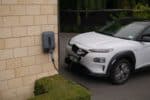
How much does it cost to charge an EV?
Unfortunately, finding out the cost to charge an electric car isn’t as straightforward as calculating the cost of a regular vehicle, where all you have to do is look at gas prices and the amount you’ve driven. There are a number of factors to take into consideration when estimating the cost of charging your electric vehicle – we’ll go over them below:
- Manufacturer-stated fuel economy – Most electric vehicles use about 34.6 kWh for every 160 km driven, according to GenCell, but you’ll need to check with your manufacturer for a more exact value. This value also depends on the type of driving you’re doing (highway or city) – with city driving, you’d need to charge your car more often than someone who predominantly drives outside the city.
- Electricity costs –This will depend on whether you’re charging at home or if you’re predominantly charging your car at charging stations. Public electric car charging stations will often charge by the hour, while some use kWh-based billing; pricing can vary from location to location. Meanwhile, charging at home can be more cost-friendly and straightforward. Regardless, to help you calculate an estimate of how you spend charging your vehicle, note the number of kilometres driven before you need to recharge, as well as the amount you pay at charging stations or the cents/kWh rate you pay for electricity at home over a few months.
- Time of Use Rates – Depending on which province you live in, time of use rates may exist – choosing to charge your EV during off-peak or mid-peak hours would be largely different than charging during peak hours, in which electricity prices are higher. In Ontario, the Ultra-Low Overnight rate offers a lower rate for energy usage between 11 p.m. and 7 a.m. The plan was created in response to the growing popularity of EVs in the province.
- Charger costs – Indirect costs are also something to consider when thinking about the costs of charging EVs – a standard charger versus a level 2 charger will have significant differences. While a level 2 charger will charge up your vehicle faster, it can cost around $2000 USD (about 2,500 CAD) for its parts and installation into your home, according to Kelley Blue Book.
How can an EV impact my electricity bill? Do time-of-use rates affect your EV charging costs?
This really depends on a few things. As we mentioned earlier, charging your vehicle overnight or during off-peak hours can prevent your monthly electricity bill from increasing.
Let’s take a look at the time-of-use pricing for Ontario for Summer 2025 (May 1 – October 31) as an example:
- 7.6 cents per kWh was the price for off-peak use,
- 12.2 cents per kWh was the price for mid-peak use
- 15.8 cents per kWh was the price for on-peak use.
Using the above prices, you could save more than half your charging costs if you chose to charge during off-peak hours.
In April 2023, Ontario also introduced a new ultra-low overnight rate. Drivers can pay a lower price when charging during the ultra-low overnight period (11 p.m. to 7 a.m.), as the price for the period is 2.8 cents/kWh. Charging during on-peak hours (4 p.m. to 9 p.m.) can cost more, as the price for the on-peak period is 28.4 cents/kWh
By shifting demand to off-peak hours, the Ontario government hopes to use more excess clean energy, while also saving EV owners up to $90 or more per year, with the off-peak rate being 67% lower than the current off-peak rate.
For individuals who don’t plan to charge at home, the electricity bill impacts will be lower; however, it can potentially cost more to charge in public stations than it does at home, since many charge by time rather than the amount used.
Let’s use another example of an Alberta driver with an assumed mileage of 1,000 km per month.
Electric vehicles vs gas-powered cars: Which type is cheaper?
There has been much conversation on whether EVs or gas-powered cars are cheaper. In terms of fuel consumption, EVs generally have lower costs. According to a 2023 study by Vincentirc, EVs on average had $19,353 in fuel cost savings. In another example, a 2024 Hyundai Ioniq 6 EV will have approximately $559.13 in electricity costs per year, while a Mitsubishi Mirage will have approximately $995.92 in fuel costs per year.
As you can see, in this specific scenario, the costs of charging an electric vehicle were significantly lower than gasoline costs. However, some factors can increase charging costs, such as the type of charger used, the make and model of the EV, and the billing system used at a charging station.
Furthermore, since electric vehicles have fewer moving parts, no exhaust system and fewer parts that need to be changed (e.g. no timing belts or fan belts), maintenance costs may also potentially be lower.
Overall, the costs of owning an electric car can potentially be lower than owning a regular gasoline car. While the upfront cost of an EV is typically high, the ownership costs can be lower in the long run.
Learn more about the cost comparison between EV and gasoline cars here. You can also use the CAA Driving Cost Calculator tool to compare the ownership costs of EVs and gas-powered cars.
How is an electric vehicle’s fuel efficiency calculated?
In Canada, an electric vehicle’s fuel efficiency is measured in kilowatt-hours per 100 kilometres (kWh/100 km). When comparing EV fuel efficiency to that of gas cars, a conversion factor is used and is expressed as gasoline litres equivalent per 100 kilometres (Le/100 km).
There are approximately 8.9 kWh per litre of gasoline according to NRCAN.
What are the most fuel-efficient electric cars in Canada?
Below is a table of the most fuel-efficient electric cars in Canada for 2025, as presented by NRCAN:
| Vehicle Class | Electric Vehicle |
| Minicompact | FIAT 500e 87 kW electric motor, 1-speed automatic |
| Subcompact | Audi S e-tron GT (20″ Wheels) 435 kW electric motor, 1-speed automatic |
| Compact | BMW i4 eDrive35 Gran Coupe (18″ Wheels) 210 kW electric motor, 1-speed automatic |
| Mid-Size | Tesla Model 3 Long Range-I 225 kW electric motor, 1-speed automatic |
| Full-size | Lucid Air Pure (19” Wheels) 358 kW electric motor, 1-speed automatic |
| Station wagon: small | Nissan ARIYA Engage 160 kW electric motor, 1-speed automatic |
| Station wagon: Mid-size | Cadillac CELESTIQ 375 kW electric motor, 1-speed automatic |
| Pickup truck: Standard | Rivian R1T (22” Wheels) 418 kW electric motor, 1-speed automatic Rivian R1T (22” Wheels) Performance Dual Max 496 kW electric motor, 1-speed automatic |
| Sport utility vehicle: Small | Tesla Model Y AWD Long Range I 221kW electric motor, 1-speed automatic |
| Sport utility vehicle: Standard | Audi Q4 45 e-tron 210 kW electric motor, 1-speed automatic |
| Minivan | Volkswagen ID.Buzz Pro 210 kW electric motor, 1-speed automatic |
Is charging electric cars free? Where to find electric car charging stations across Canada?
Depending on your location, you may be able to find free public charging stations – sites like ChargeHub or PlugShare can help you locate such stations. Note, however, that paying to charge an electric car at public charging stations is fairly common.
Is charging an EV at home safe?
It’s safe to charge an electric car at home; however, just like regular electronics, there are some precautions you should consider:
- Only use charging adaptors provided by your vehicle’s manufacturer or by an electric vehicle supply equipment manufacturer.
- Don’t use modified or damaged charging equipment.
- Don’t use any faulty charging equipment.
- Don’t use household adaptors like a multi-box, double plug or a travel plug between electric vehicle supply equipment and a socket outlet.
- Have a certified electrician install a Level 2 charger
How environmentally friendly are electric vehicles?
Electric vehicles have environmental benefits, mainly through the reduction of greenhouse gas emissions. Corporate Knights Inc. released a report where a modelling study found that if all new cars and SUVs sold by 2030 were 100% electric, greenhouse gas emissions could be reduced by 33 million tonnes per year. Additionally, if 75-80% of all new trucks were electrified by 2030, GHG emissions could be reduced by 30 Mt per year
However, they can still indirectly contribute to emissions and pollution depending on how the electricity used to power electric vehicles is generated. Electricity grid power generated by fossil fuels to fuel electric vehicles is only marginally better than gasoline-fueled vehicles emitting exhaust into the air.
Without investment in cleaner energy sources, there’s a limit to how much electric vehicles can benefit the environment.
Additionally, as stated by a CBC article, electric vehicle batteries require lithium mining, which is connected to environmental harm such as water supply contamination as well as emissions from processing.
How long do electric car batteries last?
That depends on a range of things such as the manufacturer, exposure to extreme temperatures and charging habits. On average, your electric vehicle’s car battery loses 1-2% function per year. Generally, most individuals will change vehicles long before their electric vehicle battery becomes unusable.
As a general estimate, you can expect an electric vehicle battery to last between 10-20 years before needing replacement.
Below are a few things to keep in mind in order to extend your electric vehicle’s battery life:
- Avoid prolonged usage in extreme weather conditions.
- Keep your battery charged between 60-80% – depleting your battery to 0% frequently will cause your battery to degrade faster.
- Frequently charging your vehicle will also cause your battery to degrade faster.
Is fast charging an electric vehicle costlier?
Public charging stations will charge more for the use of DC fast chargers since the equipment is expensive – according to a study from the International Council on Clean Transportation, DC Fast Chargers (DCFC) cost approximately $28,000 to $140,000 to install (per station).
How long does it take to charge an electric car at a charging station?
According to Kia, charging an electric car battery can take anywhere between half an hour to half a day, depending on your battery and the speed of the charging point you’re using.
Other factors that affect charging speed include the maximum charging rate of your vehicle, the remaining battery power, and weather conditions (charging at low temperatures takes longer than at moderate temperatures).
How to reduce electric car charging costs?
Below are a few tips you can try to reduce electric car charging costs:
- If you primarily charge your car at home and you’re in an area affected by time-of-use rates, try to do most of your charging during off-peak hours.
- Use tools like EnergyRates.ca to find the lowest electricity rates in your area.
- Use a smart charger to help manage energy consumption.
- For individuals who need to charge at public charging stations, research and compare the prices of charging at various stations. Additionally, charging electric cars for free is a possibility at some stations.
- Avoid charging your car in cold temperatures, as low temperatures will slow down the charging time, increasing your bill in the process.
As we’ve mentioned above, one way to maximize your electric car savings is through using cost comparison tools like EnergyRates.ca – you can find the lowest electricity rates in provinces where electricity is deregulated (Alberta and Ontario). Plus, our experts can also help you find green energy rates and plans to help you further limit your carbon footprint.
Learn more: What is Electrification, and How Does it Affect Energy Markets?











